
Background information
Panasonic Z95B: an OLED revolution with tandem technology?
by Luca Fontana

Panasonic Z85A tested: A mid-range OLED with high ambitions - but how does it fare against the top dogs from LG and Samsung?
Full Disclosure: The TV, the 65-inch version of the Z85A, was loaned to me by Panasonic for testing. However, Panasonic has no influence on the test result, my evaluation and the test procedure.
Panasonic televisions and I: We haven't seen each other for a while /page/review-panasonics-gzc2004-an-expensive-but-pleasant-older-fun-16600. Why is that? It's not due to a lack of quality. Panasonic has a reputation like thunder in the TV industry. The Japanese manufacturer has been combining LG's first-class OLED panels with its own in-house image processors for years - achieving results that never fail to delight picture enthusiasts and cinephiles in particular.
That's why I'm delighted to be able to take another closer look at a Panasonic television. And at the right time: just a few days ago, Panasonic caused a stir at CES 2025 when the company announced its new Tandem OLED panel, a technology that is supposed to be brighter and better than anything LG currently offers.
But back to the here and now - and the Panasonic Z85A, a 2024 model equipped with the same panel as LG's popular C-series. The question is: How much Panasonic is really in it? And can the combination of LG's hardware and Panasonic's software seriously stand up to the competition?
Like many of its competitors, Panasonic has also opted for an elegant, modern look: narrow edges and a sleek aesthetic that is strongly reminiscent of Samsung's striking "Infinity Air" design. The dark aluminium frame on the front harmonises with the black plastic back, while the square, flat stand in the middle ensures stability. However, this has a depth of 30 centimetres, which could limit the space for a soundbar in front of the TV.
And: There is only 4.5 centimetres of free space between the bottom edge of the panel and the piece of furniture. For many soundbars, which are usually placed directly in front of the TV, this is simply not enough. With my Sonos Arc, for example, the TV's infrared sensor is covered, which makes switching the TV on and off a pain every time.
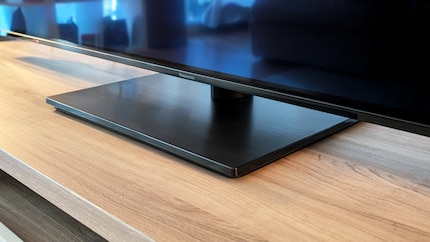
On the other hand, the Z85A impresses with an ultra-thin panel typical of OLEDs - I measured just half a centimetre at the thinnest points. At the bottom, however, where hardware such as the processor, speakers and connections are housed, the thickness is around five centimetres. LG's G series with its "Gallery" design and uniform panel thickness looks slimmer in comparison - and also more attractive when mounted on the wall. If you still want to mount the Z85A on the wall, you will need a separately available VESA 300×300 mount. You can find this here in our shop.
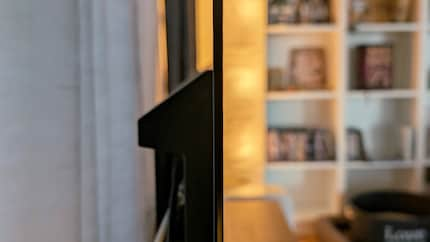
About the specs. Panasonic's Z85A offers the following:
All HDMI inputs support HLG, HDR10, HDR10+ and Dolby Vision. Dolby Atmos audio signals from external playback devices such as Blu-ray players or set-top boxes are also channelled through without any problems. The situation is somewhat bleaker for DTS:X and DTS Master Audio signals: These are converted into lower-quality multichannel PCM 7.1 and multichannel PCM 5.1 signals respectively. Important: I had to manually switch the digital audio format from "Automatic" to "Passthrough" in the sound settings beforehand, otherwise only stereo sound came through.
What comes next goes deep into the subject matter. I measure with professional tools from Portrait Display to get an objective classification of the image quality. If you are not interested in details and diagrams, you can read the following short version and then scroll to the chapter "The picture: colour variety and detail in comparison".
The most important findings in brief:
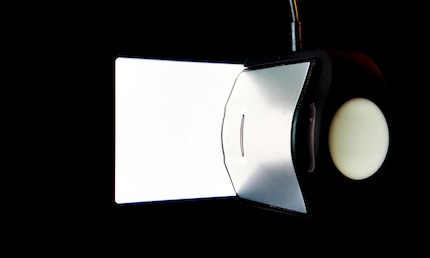
About the measurements. I measured all screen modes of the TV without calibrating it - just as the device comes out of the box. I therefore hardly made any changes to the settings:
The "Filmmaker mode" achieved the best measured values for all types of content. However, because the TV automatically switches to Dolby Vision for HDR content (there is hardly any HDR content on almost all streaming services that is not available in Dolby Vision), I only analyse the Dolby Vision measurement data. Regardless of my measurements, you should still always use gaming mode when gaming. This is due to the low input lags there. Looking for a good TV for gaming? Here you can find my guide article.
In the chart below, I compare the Z85A with its 2024 OLED competitors from LG and Samsung - the G4 and the S95D.
The first impression: somewhat sobering.
Panasonic's Z85A, the orange graph, shines just half as bright as Samsung's S95D and significantly less bright than LG's G4 with a very small image section (2% window) at 809 nits. The Z85A also shows a lower performance in terms of overall brightness (100% window) - i.e. with a screen section that covers the entire display area.
Admittedly, putting the result into context: The G4 - here in my test - uses an OLED panel with an innovative microlens layer that visibly boosts the panel's brightness. The Z85A, on the other hand, uses the same microlens-less panel as LG's C4. This also explains the big price difference between the models: Panasonic's Z85A and LG's C series "only" belong to the upper mid-range, while the G4 is a flagship model.
Samsung's S95D - here in the test - plays in a similar league to LG's G4: As a QD OLED TV, it is brighter than conventional OLED panels due to the technology - and accordingly much more expensive.
Comparing the results with other industry magazines, such as Rtngs.com, shows that the Z85A is slightly less bright than LG's C4. The difference is an average of 50 nits - a value that is barely perceptible to the naked eye.
Let's take a look at how well Panasonic's Z85A reproduces whites, colours and shades of grey. I will answer this in three questions:
Each of the 8.3 million pixels in the Z855A consists of a white, red, green and blue sub-pixel. White is created when all of them shine at the same time and with the same intensity. Full brightness therefore produces the brightest white. The lowest brightness, on the other hand, produces the darkest white. Or rather: black. In between are shades of grey of varying brightness. This is why the English term "grayscale measurement" is used.
The greater the difference between the brightest and darkest pixel, the better the contrast values. As with all my OLED TV tests, I don't measure contrast because OLED pixels can switch off completely. This means that the contrast ratio tends towards infinity anyway.
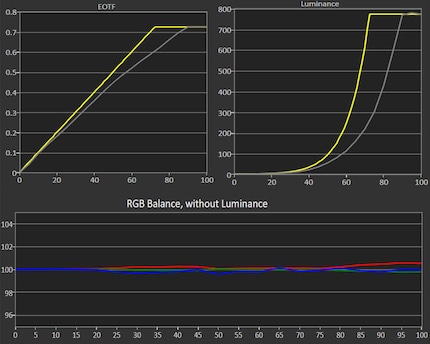
The greyscale of the Panasonic Z85A is good, but not perfect. Up to around 70 per cent brightness, the TV maintains the target value (yellow line) exactly, after which the grey tones in the brightest areas are displayed slightly darker. This may sound negative, but it could also be a deliberate move by Panasonic to protect the display or save power.
The colour balance without brightness remains very stable across the entire range. This means that the grey tones look neutral in colour without any colour appearing too strong or too weak.
Now to the measured colour balance with brightness:
In the colour balance with brightness, it is noticeable from around 60 per cent that all three colours (red, green and blue) become weaker at the same time. Between 70 and 90 per cent, the colours are significantly less intense than they should be. However, because this happens evenly, there is no visible colour cast. Most people would only perceive this as a slightly too dark image.
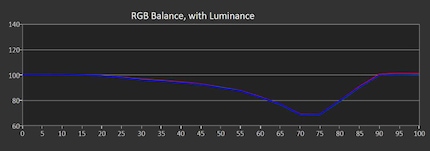
Overall, the Z85A does a good job, but doesn't come close to more expensive devices such as LG's G4 or Samsung's S95D, which are superior in bright greys and colours.
I measure the coverage of the colour spaces:
Panasonic's Z85A achieves a very good 95.03 per cent coverage in the important DCI-P3 colour space. This is just below the 96.58 per cent coverage achieved by LG's G4 or the 99.95 per cent achieved by Samsung's S95D - (QD) OLED televisions are slightly ahead in this discipline due to the technology. In practice, however, this makes no relevant difference.
When it comes to covering the very large BT.2020 colour space, Panasonic's mid-range TV performs less well at 70.92 per cent. However, this is no surprise and is due to the technology: currently, only QD OLED TVs such as Samsung's S95D achieve around 90 per cent coverage of the BT.2020 colour space. This is why the film and series industry calibrates its HDR content in the much more widely used DCI-P3 colour space. BT.2020 coverage therefore serves more as an indicator of a television's suitability for the future.
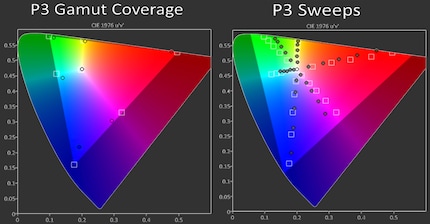
The third question: colour fidelity. This describes how accurately colours are displayed. The deviation from the TV to the reference value is referred to as DeltaE. The white boxes show the reference colours sent to the TV by the test pattern generator, the black circles show the colours actually measured.
The Z85A achieves a good DeltaE of 3.14. Although this is not the best value, it is not far off LG's G4 with its DeltaE of 2.95. Sony's Bravia 9, Sony's best mini LED TV on the market - here in the test - even has a rather mediocre DeltaE of 4.07.
The Panasonic Z85A therefore performs well in terms of colour fidelity for a mid-range model. The grey tones are well balanced and the deviations in the colours are somewhat high - which indicates the mid-range orientation of the panel - but are hardly noticeable in normal home cinema. However, flagships such as LG's G4 or Samsung's S95D offer more precise colours and greater colour gamut coverage, which is particularly noticeable with demanding HDR content.
Reflections on the screen are not measurable per se. Nevertheless, it is important to analyse them in tests. In the first comparison, I'll include a picture from my test with LG's G4. The photos were taken around midday and without me having darkened the room specifically for this purpose:
The winner here is Panasonic: on the LG G4 on the right, the orange room lamp is clearly visible, whereas on the Z85A it remains pleasantly dim. Apart from that, however, both televisions are good at swallowing and concealing ambient light.
With the picture switched on, even the Z85A, with its peak brightness of around 800 nits, is bright enough to conceal the reflections even in dark scenes. But they are not completely gone. This can be clearly seen at the beginning of "Blade Runner 2049":
This year, Samsung itself demonstrated how to perfectly handle reflections - albeit with its OLED flagship, the S95D. Here is the comparison with the TV switched on:
This is not a mistake or a retouch, the picture on the right is actually the display of the Samsung S95D photographed in exactly the same way. Reflections? Reflections? Nada. It's really bright in my living room. I'll tell it like it is: I'll probably sorely miss the anti-reflective layer that Samsung has given its OLED TV on any TV that doesn't have something similar.
Let's move on to the practical test, in which the Z85A is pitted against the current OLED flagships from LG and Samsung: the G4 and the S95D. Admittedly, it's not an entirely fair comparison - after all, the Z85A's panel belongs to the upper mid-range, roughly on a par with an LG C4. But in the absence of suitable comparison material, I have no other choice. At least it shows whether the differences between the mid-range and the "Champions League" are really that significant in practice.
If you are interested in the tests of the other TVs, you can find them here:
For testing the colour accuracy, I like to use "Guardians of the Galaxy, Vol. 2". One scene in particular is perfect for this: Drax's tattooed skin requires the TV to display fine details precisely without the brighter areas being too bright. At the same time, the scene with Ego's palace in a glowing sunset must have enough dynamics to perfectly capture the kitschy "Golden Hour" atmosphere of the planet. The Panasonic Z85A does this well and conveys the mood of the scene convincingly.
In direct comparison, however, it is noticeable that the Z85A's image tends slightly towards yellowish. LG's G4 emphasises the shadows more powerfully and therefore appears somewhat more vivid, while Samsung's S95D focuses on more realistic skin tones. Ultimately, it's a question of taste as to which picture you like better - none of the three TVs show any serious weaknesses.
Source: Disney+, "Guardians of the Galaxy, Vol. 2". Timestamp: 00:56:47.
For a change, I've added a scene from "Avatar: The Way of Water", which is perfect for testing where greens and blues dominate. The bluish skin tone of the nature-loving Na'vi in particular shows differences: LG's G4 delivers a little more dynamism here, while the skin on the Panasonic and Samsung looks slightly greyer. When flying over the jungle and out to sea, it also becomes clear that Panasonic's panel does not reach the peak brightness of LG and Samsung.
But here too, Panasonic's Z85A does not have any serious weaknesses.
Source: Disney+, "Avatar: The Way of Water". Timestamp: 00:48:10.
I think Panasonic's image in "James Bond - Skyfall" is almost perfect, namely in the scene in which James and Q are not looking at a random painting in the museum: an imposing, ageing warship that is destined to be scrapped. A subtle allusion to Bond's own situation.
Panasonic's Z85A looks pleasantly natural to me. I like that. However, LG's G4 is a tick warmer in comparison, especially in the depiction of skin tones - and I like that even better. Samsung's picture scores points in comparison with a slightly more realistic pink colour. Whether that's better? A question of taste, I guess.
Source: Apple TV+, "James Bond - Skyfall". Timestamp: 00:39:02.
How does Panasonic's Z85A perform in dark scenes? For this test, I chose the first scene from "Blade Runner 2049".
All three TVs deliver an impressively dark picture. When filming against the light, it is normal for details to be lost in black silhouettes - a phenomenon known as "black crush". I personally like the strong black. It reminds me of the plasma TVs of the past. Surprisingly, however, LG's G4 swallows up more details, while the light-coloured areas - the window, for example - have more "punch". This is probably due to the panel's actually better peak brightness. In comparison to Samsung, it is noticeable that the S95D shows a slight green-bluish tint in very bright areas, while appearing slightly more reddish in dark areas.
Panasonic's TV may be less bright overall than the LG and Samsung models, but it impresses with an excellent colour balance - as was already made clear above when measuring the "white balance".
Source: UHD-Blu-Ray, "Blade Runner 2049". Timestamp: 00:04:50.
At the end of the picture test, I check the detail reproduction in bright areas of the picture. In the following scene from "Jurassic World", you should pay attention to the sun in the background of the Panasonic Z85A: Even in such a bright image area, fine details such as the delicate contrails and the gradations of orange tones remain clearly recognisable, making the sun appear clearly as a sphere. There are no distracting white rings around the sun.
Source: UHD-Blu-Ray, "Jurassic World". Timestamp: 00:21:18.
LG's G4 and Samsung's S95D also master this task without any visible weaknesses. In fact, I would say that all three TVs reproduce the gradations almost identically. However, I had to set the smooth gradation for HDR content on LG to "Medium" to achieve this result.
The processor of a television is the central "brain". It processes the incoming image signals, analyses them and optimises the display on the screen. It reduces image noise, enhances colours, smoothes edges, ensures smoother movements and adds missing pixel information during upscaling to improve image quality.
In the Panasonic Z85A, this task is performed by the "HCX Pro AI Processor MK II" - a name that sounds like it's straight out of a sci-fi film (really, who the hell comes up with that!?). This processor can only be found in Panasonic's top-of-the-range models.
Time for the demanding Judder test, which all the TVs I tested have to undergo. Judder, a jerking or even stuttering during slow camera movements, is a phenomenon that can occur on all TVs. The film "1917" by Sam Mendes with its long, smooth camera movements is ideal for observing this. Pay particular attention to the vertical bars in the barn when comparing: do they run smoothly through the picture or do they show the aforementioned slight stuttering?
Source: UHD-Blu-Ray, "1917". Timestamp: 00:42:25.
Panasonic's processor immediately flexes its muscles: There is no trace of judder if I set Intelligent Frame Creation to "Medium" under the "Movements" menu item in the picture settings beforehand. By default, the intermediate frame calculation is switched off, which makes the picture jerk too much for my taste. On "Low" I hardly notice any difference, while on "High" the aesthetics suffer: Films and series then no longer look cinematic, but more like cheap TV soaps.
Compared to LG's Alpha 11 processor, Panasonic's MK II certainly has nothing to hide. That's saying something, because LG's processor has been one of the best in this discipline for years. I would even say that Panasonic shows less flickering and stuttering in the picture in this specific area than Samsung's Neural Quantum processor.
Next scene from "1917". Here, too, Mendes' camera work poses an immense challenge for most processors. Especially with hard edges against a blurred background, for example around the helmets of the two soldiers. Here, both the processor and the pixels have to react incredibly quickly.
Source: UHD-Blu-Ray, "1917". Timestamp: 00:35:36.
Panasonic's processor is in no way inferior to its strong competitors in this example either and looks pleasantly smooth. If I find differences in the display of the highly fluid camera movement, then only with a magnifying glass.
Next up is the Apple original "For All Mankind". Here I want to test how long it takes for a single pixel to change colour. If this doesn't happen quickly enough, it looks to you as if the image is blurred - this effect is known as "ghosting". Pay particular attention to the text displayed at the bottom left when the camera pans across the lunar landscape.
Source: Apple TV+, "For All Mankind", Season 1, Episode 5. Timestamp: 00:00:10.
Difficulties? Not a trace. In comparison with Samsung's S95D, you can even see a slight judder around the rocket when the moon passes by in the background. With Panasonic, on the other hand, everything remains smooth and the superimposed text is always razor-sharp.
This is anything but a matter of course. To show what I mean, I have added a comparison with the C82 model from TCL at the end. To be fair, it should be mentioned that this is a device that is two years older. The example should therefore only serve as an illustration, especially as TCL has already achieved significant improvements in the successor models.
Now for the most demanding test: I want to find out how well the processor can improve low-quality sources - be it Blu-rays, live TV or "The Walking Dead". This series was deliberately shot on 16mm film to create a damaged, post-apocalyptic atmosphere through the film grain and image noise. Pay particular attention to the dark area between the two hostile men.
Source: Netflix, "The Walking Dead", Season 7, Episode 1. timestamp: 00:02:30.
Once again, I'm looking for the differences between Panasonic's and LG's processing power with a magnifying glass - even during paused scenes. Hats off. However, Panasonic clearly wins in the comparison with Samsung: If you pause the clip, for example here, you immediately see unsightly artefacts and image errors with Samsung. But not with Panasonic. There is virtually no image noise and hardly any compression artefacts. The picture is sharply defined, pleasantly warm, rich and at most a touch too red.
When measuring the colour accuracy in True Game Mode, I achieved an average delta E of a good 4.19 (you can find a detailed explanation in the section "White balance, colours and grey tones"). This is only slightly worse than the Delta E of 3.44 that I measured on LG's G4.
On the topic of input lag: With the measuring device from Leo Bodnar, I measured an average input lag of 13.2 milliseconds with a UHD image at 60 frames per second and HDR enabled. This is a very good value and not far off the level of the LG G4 - which achieves 9.8 milliseconds here. The value is also below the 20 milliseconds that a game mode should achieve.
Apart from this, the TV supports all features relevant for gamers:
To this end, Panasonic, Sony, LG, Philips, TCL and Samsung have entered into a partnership with major gaming studios. The result is the HGiG - the HDR Gaming Interest Group. According to the manufacturer, the aim is to ensure that HDR is displayed as intended by the game developers, for example when playing "Spider-Man 2" on my PlayStation 5.
Source: PS5 Pro, "Spider-Man 2", variable 120Hz mode, HDR, VRR and ray tracing enabled
What Panasonic delivers here with the Z85A in gaming mode is a real feast for the eyes. At a buttery smooth 120 frames per second, I glide through the urban canyons of New York, take down opponents in heated battles and swing effortlessly across the iconic skyline. The minimally noticeable input lag ensures that every movement I make is translated to the screen at lightning speed - a decisive advantage in action-packed games like "Spider-Man 2" on the PS5 Pro.
Particularly impressive is how Panasonic's OLED panel brings colours and contrasts to life: bright red and blue on Spider-Man's suit literally glow, while deep black provides the perfect counterpoint. Even with the fastest camera pans, the picture remains razor-sharp and the details clearly recognisable.
With Fire TV, Panasonic has been relying on Amazon's operating system since 2024, which is particularly attractive for households that are already part of the Amazon ecosystem. A key feature is the integration of Alexa, which allows the TV to be controlled entirely by voice command, from navigating through menus and streaming services to controlling smart home devices such as lights, cameras or thermostats.
Amazon services such as Prime Video, Amazon Music and Luna, the company's own cloud gaming service, are also prominently embedded in the system. Those who use these platforms intensively will benefit from the seamless integration. At the same time, Fire TV offers a wide selection of apps, including Netflix, YouTube, Disney+ and Plex, so that all popular streaming services are available.
Source: Panasonic Fire TV
However, the focus is clearly on Amazon's own services. And when setting up the TV for the first time, an Amazon account is literally forced upon you if you don't already have one. Also annoying: downloading apps such as Plex or DAZN from the Appstore takes ages. Fortunately, you only have to do this once per app - and once they are installed, they run smoothly and load quickly.
Homes that rely heavily on Google services or Apple products will hardly recognise any advantages over Google TV or Apple's tvOS. Google TV in particular has established itself with TV manufacturers such as Sony, Philips and TCL and offers similar functionality. Fire TV therefore appeals to those who use Alexa and other Amazon products intensively and want a more integrated smart home hub in their TV.
Panasonic's Z85A is a solid upper mid-range OLED TV that scores particularly well in terms of colour balance and colour accuracy. The "HCX Pro AI Processor MK II" impresses with excellent motion processing and minimal image noise, even with demanding sources. The Z85A shows weaknesses in peak brightness, which at 809 nits lags behind the flagship models from LG and Samsung.
Gamers will get their money's worth: with low input lag, 4K120Hz and comprehensive VRR support, the TV is ideally equipped for action-packed games. The Fire TV operating system, on the other hand, is impressive in Amazon-centred households, but remains functional and unspectacular outside of this ecosystem.
All in all, if you are looking for an attractively priced alternative to the high-end models and can do without extreme brightness, the Panasonic Z85A is an excellent all-rounder.
Pro
Contra
I write about technology as if it were cinema, and about films as if they were real life. Between bits and blockbusters, I’m after stories that move people, not just generate clicks. And yes – sometimes I listen to film scores louder than I probably should.